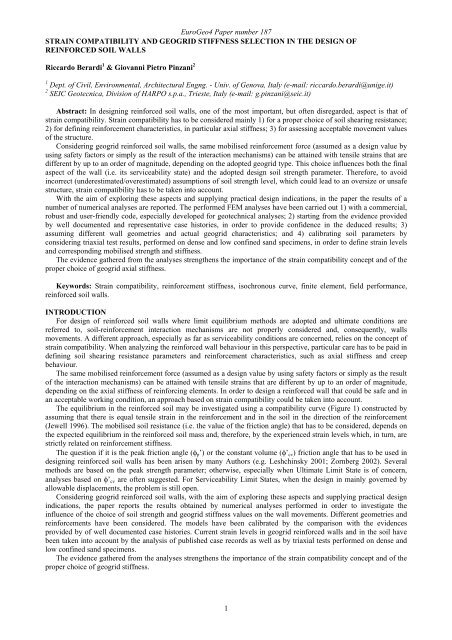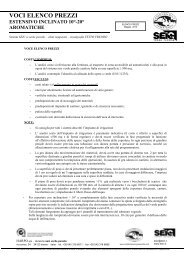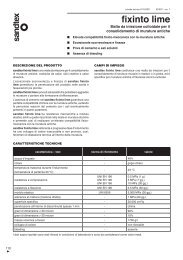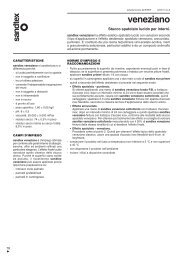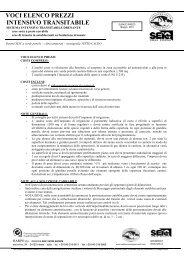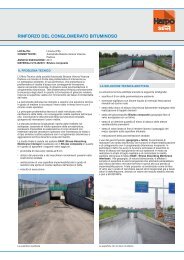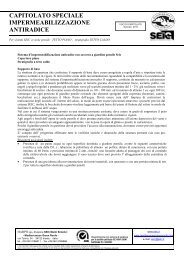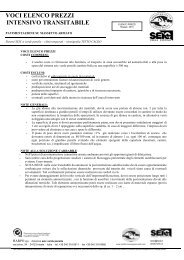Strain Compatibility and Geogrid Stiffness Selection in ... - Harpo spa
Strain Compatibility and Geogrid Stiffness Selection in ... - Harpo spa
Strain Compatibility and Geogrid Stiffness Selection in ... - Harpo spa
You also want an ePaper? Increase the reach of your titles
YUMPU automatically turns print PDFs into web optimized ePapers that Google loves.
EuroGeo4 Paper number 187STRAIN COMPATIBILITY AND GEOGRID STIFFNESS SELECTION IN THE DESIGN OFREINFORCED SOIL WALLSRiccardo Berardi 1 & Giovanni Pietro P<strong>in</strong>zani 21 Dept. of Civil, Environmental, Architectural Engng. - Univ. of Genova, Italy (e-mail: riccardo.berardi@unige.it)2 SEIC Geotecnica, Division of HARPO s.p.a., Trieste, Italy (e-mail: g.p<strong>in</strong>zani@seic.it)Abstract: In design<strong>in</strong>g re<strong>in</strong>forced soil walls, one of the most important, but often disregarded, aspect is that ofstra<strong>in</strong> compatibility. <strong>Stra<strong>in</strong></strong> compatibility has to be considered ma<strong>in</strong>ly 1) for a proper choice of soil shear<strong>in</strong>g resistance;2) for def<strong>in</strong><strong>in</strong>g re<strong>in</strong>forcement characteristics, <strong>in</strong> particular axial stiffness; 3) for assess<strong>in</strong>g acceptable movement valuesof the structure.Consider<strong>in</strong>g geogrid re<strong>in</strong>forced soil walls, the same mobilised re<strong>in</strong>forcement force (assumed as a design value byus<strong>in</strong>g safety factors or simply as the result of the <strong>in</strong>teraction mechanisms) can be atta<strong>in</strong>ed with tensile stra<strong>in</strong>s that aredifferent by up to an order of magnitude, depend<strong>in</strong>g on the adopted geogrid type. This choice <strong>in</strong>fluences both the f<strong>in</strong>alaspect of the wall (i.e. its serviceability state) <strong>and</strong> the adopted design soil strength parameter. Therefore, to avoid<strong>in</strong>correct (underestimated/overestimated) assumptions of soil strength level, which could lead to an oversize or unsafestructure, stra<strong>in</strong> compatibility has to be taken <strong>in</strong>to account.With the aim of explor<strong>in</strong>g these aspects <strong>and</strong> supply<strong>in</strong>g practical design <strong>in</strong>dications, <strong>in</strong> the paper the results of anumber of numerical analyses are reported. The performed FEM analyses have been carried out 1) with a commercial,robust <strong>and</strong> user-friendly code, especially developed for geotechnical analyses; 2) start<strong>in</strong>g from the evidence providedby well documented <strong>and</strong> representative case histories, <strong>in</strong> order to provide confidence <strong>in</strong> the deduced results; 3)assum<strong>in</strong>g different wall geometries <strong>and</strong> actual geogrid characteristics; <strong>and</strong> 4) calibrat<strong>in</strong>g soil parameters byconsider<strong>in</strong>g triaxial test results, performed on dense <strong>and</strong> low conf<strong>in</strong>ed s<strong>and</strong> specimens, <strong>in</strong> order to def<strong>in</strong>e stra<strong>in</strong> levels<strong>and</strong> correspond<strong>in</strong>g mobilised strength <strong>and</strong> stiffness.The evidence gathered from the analyses strengthens the importance of the stra<strong>in</strong> compatibility concept <strong>and</strong> of theproper choice of geogrid axial stiffness.Keywords: <strong>Stra<strong>in</strong></strong> compatibility, re<strong>in</strong>forcement stiffness, isochronous curve, f<strong>in</strong>ite element, field performance,re<strong>in</strong>forced soil walls.INTRODUCTIONFor design of re<strong>in</strong>forced soil walls where limit equilibrium methods are adopted <strong>and</strong> ultimate conditions arereferred to, soil-re<strong>in</strong>forcement <strong>in</strong>teraction mechanisms are not properly considered <strong>and</strong>, consequently, wallsmovements. A different approach, especially as far as serviceability conditions are concerned, relies on the concept ofstra<strong>in</strong> compatibility. When analyz<strong>in</strong>g the re<strong>in</strong>forced wall behaviour <strong>in</strong> this perspective, particular care has to be paid <strong>in</strong>def<strong>in</strong><strong>in</strong>g soil shear<strong>in</strong>g resistance parameters <strong>and</strong> re<strong>in</strong>forcement characteristics, such as axial stiffness <strong>and</strong> creepbehaviour.The same mobilised re<strong>in</strong>forcement force (assumed as a design value by us<strong>in</strong>g safety factors or simply as the resultof the <strong>in</strong>teraction mechanisms) can be atta<strong>in</strong>ed with tensile stra<strong>in</strong>s that are different by up to an order of magnitude,depend<strong>in</strong>g on the axial stiffness of re<strong>in</strong>forc<strong>in</strong>g elements. In order to design a re<strong>in</strong>forced wall that could be safe <strong>and</strong> <strong>in</strong>an acceptable work<strong>in</strong>g condition, an approach based on stra<strong>in</strong> compatibility could be taken <strong>in</strong>to account.The equilibrium <strong>in</strong> the re<strong>in</strong>forced soil may be <strong>in</strong>vestigated us<strong>in</strong>g a compatibility curve (Figure 1) constructed byassum<strong>in</strong>g that there is equal tensile stra<strong>in</strong> <strong>in</strong> the re<strong>in</strong>forcement <strong>and</strong> <strong>in</strong> the soil <strong>in</strong> the direction of the re<strong>in</strong>forcement(Jewell 1996). The mobilised soil resistance (i.e. the value of the friction angle) that has to be considered, depends onthe expected equilibrium <strong>in</strong> the re<strong>in</strong>forced soil mass <strong>and</strong>, therefore, by the experienced stra<strong>in</strong> levels which, <strong>in</strong> turn, arestrictly related on re<strong>in</strong>forcement stiffness.The question if it is the peak friction angle (φ p ’) or the constant volume (φ’ cv ) friction angle that has to be used <strong>in</strong>design<strong>in</strong>g re<strong>in</strong>forced soil walls has been arisen by many Authors (e.g. Leshch<strong>in</strong>sky 2001; Zornberg 2002). Severalmethods are based on the peak strength parameter; otherwise, especially when Ultimate Limit State is of concern,analyses based on φ’ cv are often suggested. For Serviceability Limit States, when the design <strong>in</strong> ma<strong>in</strong>ly governed byallowable displacements, the problem is still open.Consider<strong>in</strong>g geogrid re<strong>in</strong>forced soil walls, with the aim of explor<strong>in</strong>g these aspects <strong>and</strong> supply<strong>in</strong>g practical design<strong>in</strong>dications, the paper reports the results obta<strong>in</strong>ed by numerical analyses performed <strong>in</strong> order to <strong>in</strong>vestigate the<strong>in</strong>fluence of the choice of soil strength <strong>and</strong> geogrid stiffness values on the wall movements. Different geometries <strong>and</strong>re<strong>in</strong>forcements have been considered. The models have been calibrated by the comparison with the evidencesprovided by of well documented case histories. Current stra<strong>in</strong> levels <strong>in</strong> geogrid re<strong>in</strong>forced walls <strong>and</strong> <strong>in</strong> the soil havebeen taken <strong>in</strong>to account by the analysis of published case records as well as by triaxial tests performed on dense <strong>and</strong>low conf<strong>in</strong>ed s<strong>and</strong> specimens.The evidence gathered from the analyses strengthens the importance of the stra<strong>in</strong> compatibility concept <strong>and</strong> of theproper choice of geogrid stiffness.1
EuroGeo4 Paper number 187Figure 1. Example of compatibility curveSTRAIN LEVELS FROM CASE HISTORIESIn order to consider the displacements <strong>and</strong> stra<strong>in</strong> levels actually experienced <strong>in</strong> walls <strong>and</strong> <strong>in</strong> their re<strong>in</strong>forc<strong>in</strong>gelements, that have to be compared with soil stra<strong>in</strong>s occurr<strong>in</strong>g <strong>in</strong> peak/constant volume conditions, a number of casehistories have been considered. Only very well documented cases could supply detailed <strong>in</strong>formation useful for thescope, so the database collected <strong>and</strong> published by Allen <strong>and</strong> Bathurst (2002) <strong>and</strong> Bathurst et al. (2002) has been taken<strong>in</strong>to account. The reported measurements refer to walls characterized by different heights (H=3÷12 m); fac<strong>in</strong>g type(wrapped-around, segmental, concrete panel, etc.); re<strong>in</strong>forc<strong>in</strong>g elements (uniaxial/biaxial geogrids, woven/non wovengeotextiles); polymer (HDPE, PP, PET), soil gradation; measurement technique (local/global).Peak axial stra<strong>in</strong>s <strong>in</strong> the re<strong>in</strong>forcements do not exceed 3% with a slight <strong>in</strong>crease due to creep phenomena; <strong>in</strong> mostcases stra<strong>in</strong>s are less than 1%. The ratio of the maximum horizontal displacement of the fac<strong>in</strong>g to the wall height(U x /H) ranges between 0.1 to 1.5%. At failure peak stra<strong>in</strong> <strong>in</strong>creases up to 10%.Mc Gown et al. (1998) states that the maximum stra<strong>in</strong> measured <strong>in</strong> re<strong>in</strong>forc<strong>in</strong>g elements is usually much less than2%; the values above reported well agree with this <strong>in</strong>dication.MOBILISED SOIL STRENGTHThe mechanical behaviour of compacted soil fill is characterized by dilation due to high relative density <strong>and</strong> lowconf<strong>in</strong><strong>in</strong>g stresses. Consider<strong>in</strong>g usual wall heights <strong>and</strong> soil unit weight, mean stress less than, say, 100 kN/m 2 , couldbe assumed. Therefore, for properly compacted fills, differences up to 13° between peak (φ p ’) <strong>and</strong> constant volume(φ’ cv ) friction angles should be taken <strong>in</strong>to account (Bolton, 1986). Figure 2 illustrates dilation <strong>in</strong>fluence on the peakshear strength.Follow<strong>in</strong>g the concept of stra<strong>in</strong> compatibility between soil <strong>and</strong> re<strong>in</strong>forcement, it appears relevant to assess theaverage stra<strong>in</strong> levels to which peak <strong>and</strong> constant volume state have to be referred. Various Authors suggest the stra<strong>in</strong>range ε=3÷6% for mobilisation of peak strength <strong>and</strong> stra<strong>in</strong>s up to 12% for reach<strong>in</strong>g constant volume conditions (McGown et al. 1998).Figure 2. Dilatancy effects on s<strong>and</strong> strength (Bolton’s data, from Jewell 1996)2
EuroGeo4 Paper number 187In order to verify these f<strong>in</strong>d<strong>in</strong>gs (based on experimental evidences) a set of triaxial compression tests on a uniformsilica s<strong>and</strong> (Tic<strong>in</strong>o S<strong>and</strong>), hav<strong>in</strong>g relative density D R rang<strong>in</strong>g from 70 to 80% have been <strong>in</strong>terpreted. The ma<strong>in</strong>properties of the tested s<strong>and</strong> are <strong>in</strong>dicated <strong>in</strong> Table 1. Low conf<strong>in</strong><strong>in</strong>g stresses (σ’ 3 =20÷50 kN/m 2 ) have been applied.The results, illustrated <strong>in</strong> Figure 3, <strong>in</strong>dicate that the peak strength is mobilized for axial stra<strong>in</strong>s ε 1 =2÷4%, whileconstant volume conditions are atta<strong>in</strong>ed for ε 1 >10%.Table 1. Summary of ma<strong>in</strong> physical properties of Tic<strong>in</strong>o S<strong>and</strong>G S D 50 (mm) U % f<strong>in</strong>es (
EuroGeo4 Paper number 187heigth from wall base (m)654321GW8-FEMGW8-stra<strong>in</strong>gagePWRI-FEMPWRI-stra<strong>in</strong>gage00,0% 0,5% 1,0% 1,5%peak stra<strong>in</strong> ε peakFigure 4. Comparison between measured <strong>and</strong> calculated re<strong>in</strong>forcement peak stra<strong>in</strong>sheigth from wall base [m]65432GW11-stra<strong>in</strong>gagesGW11-FEMGW9-<strong>in</strong>cl<strong>in</strong>ometerGW9-FEM100 20 40 60 80horizontal displacement Ux [mm]Figure 5. Comparison between measured <strong>and</strong> calculated wall horizontal displacements<strong>Selection</strong> of geogrid stiffnessThe re<strong>in</strong>forcement geometrical <strong>and</strong> mechanical characteristics obviously <strong>in</strong>fluence wall performance, both withregard to stability conditions <strong>and</strong> to global displacements. In the numerical analyses the re<strong>in</strong>forcements are modelledas flexible elastic elements that can susta<strong>in</strong> only tensile forces (no compression). The only property to def<strong>in</strong>e is theaxial stiffness EA, that is the ratio of the axial force per unit width <strong>and</strong> the axial stra<strong>in</strong>. Different values of the axialstiffness can be so determ<strong>in</strong>ed by the knowledge of the normalized isochronous curve of the re<strong>in</strong>forcement, hav<strong>in</strong>gdef<strong>in</strong>ed the ultimate tensile strength.As far as soil-geogrid <strong>in</strong>teraction is concerned, around the re<strong>in</strong>forcements set of <strong>in</strong>terfaces (suited to model bondmechanisms) <strong>and</strong> ref<strong>in</strong>ement have been applied. The <strong>in</strong>terface strength (analogous to an “efficiency” parameter) canbe def<strong>in</strong>ed accord<strong>in</strong>g to soil <strong>and</strong> geogrid characteristics, as outl<strong>in</strong>ed by Jewell (1996).Two different geogrids are considered <strong>in</strong> the follow<strong>in</strong>g. Table 3 <strong>and</strong> Figure 6 report, respectively, the ma<strong>in</strong>characteristics <strong>and</strong> the isochronous curves.Table 3. Summary of geogrid general characteristicsName Symbol Description Polymer Grid size(mm)EnkagridPRO/40<strong>Harpo</strong>ter40/20Ultimate TensileStrength(kN/m)Tolerance TensileStrength(kN/m)EG Extruded bars(laser welded)PET 40x94 48 40HT Woven PET 15x15 40 40(PVC coated)4
EuroGeo4 Paper number 187Figure 6. Isochronous curves for geogrids EG (left) <strong>and</strong> HT (right)<strong>Geogrid</strong> “EG” is evidently stiffer than “HT”; the choice of select<strong>in</strong>g these types of re<strong>in</strong>forc<strong>in</strong>g elements has beenmade just to enhance the importance of re<strong>in</strong>forcement behaviour <strong>in</strong> approaches based on stra<strong>in</strong> compatibility.Assum<strong>in</strong>g secant stiffness values, calculated with regard to stra<strong>in</strong> levels (Figure 7), the differences are moreevident <strong>and</strong> stress the importance of def<strong>in</strong><strong>in</strong>g <strong>in</strong> which range the wall (<strong>and</strong> thus the soil) is expected to work. A stiffgeogrid, such as type EG, show very high performance especially for stra<strong>in</strong> levels less than 2-3%, typical value, asobserved <strong>in</strong> the section dedicated to the analysis of case histories, for re<strong>in</strong>forcements walls <strong>in</strong> a work<strong>in</strong>g state. On thecontrary, geogrid like type HT, are characterized by a low <strong>and</strong> almost constant stiffness, regardless to the mobilisedstra<strong>in</strong> (<strong>and</strong> strength) level.The numerical analyses have been carried out assum<strong>in</strong>g different values of axial stiffness, as <strong>in</strong>dicated <strong>in</strong> Table 4.20001750stiffness EA (kN/m)150012501000750500250EGHT00 2 4 6 8 10 12 14stra<strong>in</strong> (%)Figure 7. Axial stiffness for geogrids EG <strong>and</strong> HTTable 4. Summary of geogrid performance characteristics considered <strong>in</strong> FEM analyses<strong>Stra<strong>in</strong></strong> (%) Stress ratio EG (%) Stress ratio HT (%) <strong>Stiffness</strong> EG (kN/m) <strong>Stiffness</strong> HT (kN/m)0.5 20 - 1920 -1 25 10 1250 3502 35 20 850 3003 45 - 720 -5 75 30 720 2505
EuroGeo4 Paper number 187Cases considered <strong>in</strong> numerical analysesThe numerical analyses are aimed to highlight the importance of consider<strong>in</strong>g compatibility conditions betweenre<strong>in</strong>forcement <strong>and</strong> soil. Therefore, soil parameters representative of a different mobilization of soil strength have beenassumed, together with the two geogrids EG <strong>and</strong> HT.Three walls of different heights (4, 6, 8 m) are analyzed; the models have been generated start<strong>in</strong>g from theevidences gathered <strong>in</strong> the calibration phase, extend<strong>in</strong>g to the new cases the choices <strong>and</strong> parameters there adopted. Thewalls have a wrapped-around fac<strong>in</strong>g; the ratio of the geogrid length L to the wall height H is equal to 0.5, <strong>in</strong> order tohave relatively high stressed re<strong>in</strong>forcements. On the backfill acts a surcharge. Dry conditions are assumed. A sketch ofthe adopted mesh is illustrated <strong>in</strong> Figure 8; Tables 5 <strong>and</strong> 6 report geometrical <strong>and</strong> soil characteristics . The analyseshave been performed with the elastic perfectly-plastic Mohr-Coulomb soil model.Figure 8. Example of adopted meshTable 5. Summary of geogrid performance characteristics considered <strong>in</strong> FEM analysesCase GW-H4 GW-H6 GW-H8Height H (m) 4.2 6.0 7.8<strong>Geogrid</strong> total length L (m) 2.0 3.0 4.0Vertical <strong>spa</strong>c<strong>in</strong>g Sv (m) 0.60 0.60 0.60L/H ~ 0.5 0.5 ~ 0.5Sv/H 0.14 0.10 0.08Number of re<strong>in</strong>forcements 7 10 13Overlap length (m) 0.8 1.2 1.6Surcharge q (kN/m 2 ) 50 80 100q/σ v (H/2) ~ 1.3 ~ 1.5 ~ 1.4Table 6. Soil ma<strong>in</strong> characteristicsSoil type # 1 # 2Backfill unit weight γ (kN/m 3 ) 18.0 18.0Friction angle φ’ p 45° 39°Constant volume friction angle φ’ cv 32° 32°Dilatancy angle ψ 15° 8°Young modulus E (MN/m 2 ) 60 24Shear modulus G (MN/m 2) 25 10Poisson’s ratio 0.2 0.2The soil type #1 may be referred to at-rest or “pre-peak” conditions while type #2 is <strong>in</strong>troduced for a fictitioussimulation of “post-peak” conditions, both for strength <strong>and</strong> deformability parameters.RESULTSA set of “calibration” analyses has been carried out on the wall GW-H6 <strong>in</strong> order to assess the mean level of tensilestra<strong>in</strong> <strong>in</strong> the re<strong>in</strong>forcements. It is worth observ<strong>in</strong>g that these are assumed as global stra<strong>in</strong>s, calculated consider<strong>in</strong>g the“net” horizontal displacement, which is deduct<strong>in</strong>g from the total displacement of the geogrid the value at the rear.These tests are been made vary<strong>in</strong>g the geogrid stiffness (Table 4) <strong>and</strong> adopt<strong>in</strong>g soil type #1. As expected, theresults are particularly affected by the value of EA for the stiff geogrid EG, be<strong>in</strong>g the peak stra<strong>in</strong> ε however less than1%. On the contrary, for geogrid HT, ε is always higher than 1% , with maximum values reach<strong>in</strong>g 3%.6
EuroGeo4 Paper number 187With effect from these prelim<strong>in</strong>ary outcomes, all the walls have been simulated, consider<strong>in</strong>g, accord<strong>in</strong>g to soilre<strong>in</strong>forcementstra<strong>in</strong> compatibility:• <strong>Geogrid</strong> EG – stiffness EA=1250 kN/m - Soil type #1• <strong>Geogrid</strong> HT – stiffness EA=250 kN/m - Soil type #1 – Soil type #2Because of the typical stra<strong>in</strong> levels expected for very extensible geogrids, like HT, it appeared more appropriatedanalyz<strong>in</strong>g the so re<strong>in</strong>forced wall performance with both soil types.The results of the numerical analyses are summarized plott<strong>in</strong>g peak stra<strong>in</strong>s ε <strong>and</strong> normalized horizontaldisplacements (Ux/H) aga<strong>in</strong>st normalized re<strong>in</strong>forcement heights (Y/H) (Figures 9-10).Figures 11 reports the values of the maximum tensile force mobilized <strong>in</strong> each re<strong>in</strong>forcement (divided by theultimate value); the distributions along wall height <strong>and</strong> along geogrid length (not shown) follow the expected trends.Y / H10,80,60,4geogrid EGGW-H4 - #1GW-H6 - #1GW-H8 - #110,80,60,4geogrid HTGW-H4 - #1GW-H6 - #1GW-H8 - #1GW-H4 - #2GW-H6 - #2GW-H8 - #20,20,200,0% 0,2% 0,4% 0,6% 0,8% 1,0%ε00% 2% 4% 6% 8% 10%εFigure 9. <strong>Stra<strong>in</strong></strong>s <strong>in</strong> re<strong>in</strong>forc<strong>in</strong>g elements1geogrid EG1geogrid HT0,80,8Y / H0,60,40,20GW-H4 - #1GW-H6 - #1GW-H8 - #10,0% 0,2% 0,4% 0,6% 0,8% 1,0%Ux/HFigure 10. Horizontal displacements <strong>in</strong> re<strong>in</strong>forced walls0,6GW-H4 - #10,4GW-H6 - #1GW-H8 - #1GW-H4 - #20,2GW-H6 - #2GW-H8 - #200% 2% 4% 6% 8% 10%Ux/H1,0geogrid EGGW-H4 - #1GW-H6 - #10,8GW-H8 - #10,6Y/H0,40,20,00,0 0,1 0,1 0,2 0,2 0,3 0,3 0,4T max /T ult1,0geogrid HTGW-H4 - #1GW-H6 - #1GW-H8 - #10,80,6GW-H4 - #2GW-H6 - #2GW-H8 - #20,40,20,00,0 0,1 0,2 0,3 0,4 0,5 0,6 0,7 0,8Figure 11. Tensile forces mobilized <strong>in</strong> the re<strong>in</strong>forcements7
EuroGeo4 Paper number 187The obta<strong>in</strong>ed results allow to remark that:• as expected, when stiff re<strong>in</strong>forc<strong>in</strong>g elements are adopted, the global displacements are limited, allow<strong>in</strong>g thestructure to be considered <strong>in</strong> a serviceability limit state;• the displacements are obviously also affected by the soil mechanical characteristics, which, <strong>in</strong> turn, may beaffected by the compaction quality or, if proper techniques are adopted <strong>and</strong> backfill soil shows dilativebehaviour, by the <strong>in</strong>duced stra<strong>in</strong> levels;• for these reasons it is important, <strong>in</strong> the selection of the values of soil parameters, tak<strong>in</strong>g <strong>in</strong>to account that withvery extensible geogrids large displacements <strong>and</strong> stra<strong>in</strong>s will take place; <strong>in</strong> this case it is more difficult todef<strong>in</strong>e which value of soil strength is to be considered;• for geogrids characterized by low axial stiffness, it seems advisable to assume the constant volume frictionangle φ’ cv , this result<strong>in</strong>g <strong>in</strong> a more correct <strong>and</strong> conservative choice of soil strength;• design<strong>in</strong>g with high stiffness geogrids, on the other h<strong>and</strong>, allows to consider peak strength condition, at leastas far as serviceability states are considered; the stra<strong>in</strong> levels <strong>in</strong> the re<strong>in</strong>forcements, <strong>in</strong> fact, are compatiblewith the stra<strong>in</strong>s mobilized <strong>in</strong> the soil before reach<strong>in</strong>g its peak resistance,• the stress ratio mobilized <strong>in</strong> the stiff re<strong>in</strong>forcements (adopt<strong>in</strong>g peak friction angle (φ p ’) are almost half the onesfor very extensible geogrids with same ultimate strength (but lower friction angle);• this means that <strong>in</strong> the former case the wall is stable with adequate level of safety while <strong>in</strong> the latter the stabilityconditions are critical, the safety factors low <strong>and</strong>, aga<strong>in</strong>, the displacements probably unacceptable.CONCLUSIONSIn the paper the problem of stra<strong>in</strong> compatibility between soil <strong>and</strong> geosynthetic re<strong>in</strong>forcement has been consideredas far as geogrid re<strong>in</strong>forced walls are concerned.The careful analysis of well selected case histories has <strong>in</strong>dicate that, at work<strong>in</strong>g state, <strong>in</strong> the re<strong>in</strong>forc<strong>in</strong>g elementsthe mobilised stra<strong>in</strong>s are usually compatible with the levels of stra<strong>in</strong> experienced <strong>in</strong> dilative soil <strong>in</strong> pre-peakconditions.In consider<strong>in</strong>g stra<strong>in</strong> compatibility as a design approach, particularly for serviceability limit state, the selection ofgeogrid axial stiffness plays a relevant role, because the soil strength parameters have to be chosen with respect to theexpected wall displacements.The use of stiff geogrids results <strong>in</strong> small displacements <strong>and</strong> <strong>in</strong> a safe mobilization of soil <strong>and</strong> re<strong>in</strong>forcementstrengths. The opposite verifies for very extensible geogrids.These aspects are also relevant if one considers the possible creep phenomena <strong>in</strong> re<strong>in</strong>forced walls, which may havevery negative consequences for wall displacements, when occurr<strong>in</strong>g <strong>in</strong> an already high loaded <strong>and</strong> stra<strong>in</strong>ed re<strong>in</strong>forc<strong>in</strong>gelement, characterized by a low axial stiffness.Acknowledgements: The authors acknowledge the careful work done by A Verardo, M Tabellario <strong>and</strong> E Mortola.Correspond<strong>in</strong>g author: Prof Riccardo Berardi, Dept. of Civil, Environmental, Architectural Engng. - Univ. ofGenova, Via Montallegro, 1, Genova, 16145, Italy. Tel: +39 010 353 2506/2491. Email: riccardo.berardi@unige.it.REFERENCESAllen, T.M., & Bathurst, R.J. 2002. Soil re<strong>in</strong>forcement loads <strong>in</strong> geosynthetic walls at work<strong>in</strong>g stress conditions.Geosynthetics International, vol 9, No 5-6, 525-566.Allen, T.M., Bathurst, R.J. & Berg, R.R. 2002. Global level of safety <strong>and</strong> performance of geosynthetic walls: anhistorical perspective. Geosynthetics International, vol 9, No 5-6, 395-450.Bathurst, R.J., Allen, T.M., & Walters, D.L. 2002. Short term stra<strong>in</strong> <strong>and</strong> deformation behavior of geosynthetic walls atwork<strong>in</strong>g stress conditions. Geosynthetics International, vol 9, No 5-6, 451-482.Bolton, M.D. 1986. The strength <strong>and</strong> dilatancy of s<strong>and</strong>s. Géotechnique, 36, No.1, 65-78.Jewell, R. 1996. Soil re<strong>in</strong>forcement with geotextiles. CIRIA Special Publication 123, Thomas Telford, pp. 332.Leshch<strong>in</strong>sky, D. 2001. Design dilemma: use peak or residual strength of soil. Geotextiles <strong>and</strong> Geomembranes, vol.19,111-125.L<strong>in</strong>g, H.I., Cardany, C.P., Sun, L-X & Hashimoto, H. 2000. F<strong>in</strong>ite Element study of a geosynthetic-re<strong>in</strong>forced soilreta<strong>in</strong><strong>in</strong>g wall with concrete-block fac<strong>in</strong>g. Geosynthetics International, vol. 7, No. 3, 163-188.Mc Gown, A., Andrawes, K.Z., Pradham, S. & Khan, A.J. 1998. Limit state design of geosynthetic re<strong>in</strong>forcedstructures. Proceed<strong>in</strong>gs. 6 th Int. Conference on Geosynthetics, Atlanta, IFAI, 143-179.Zornberg, J.G. 2002. Peak versus residual shear strength <strong>in</strong> geosynthetic-re<strong>in</strong>forced soil design. GeosyntheticsInternational, vol. 9, No. 4, 301-318.8


